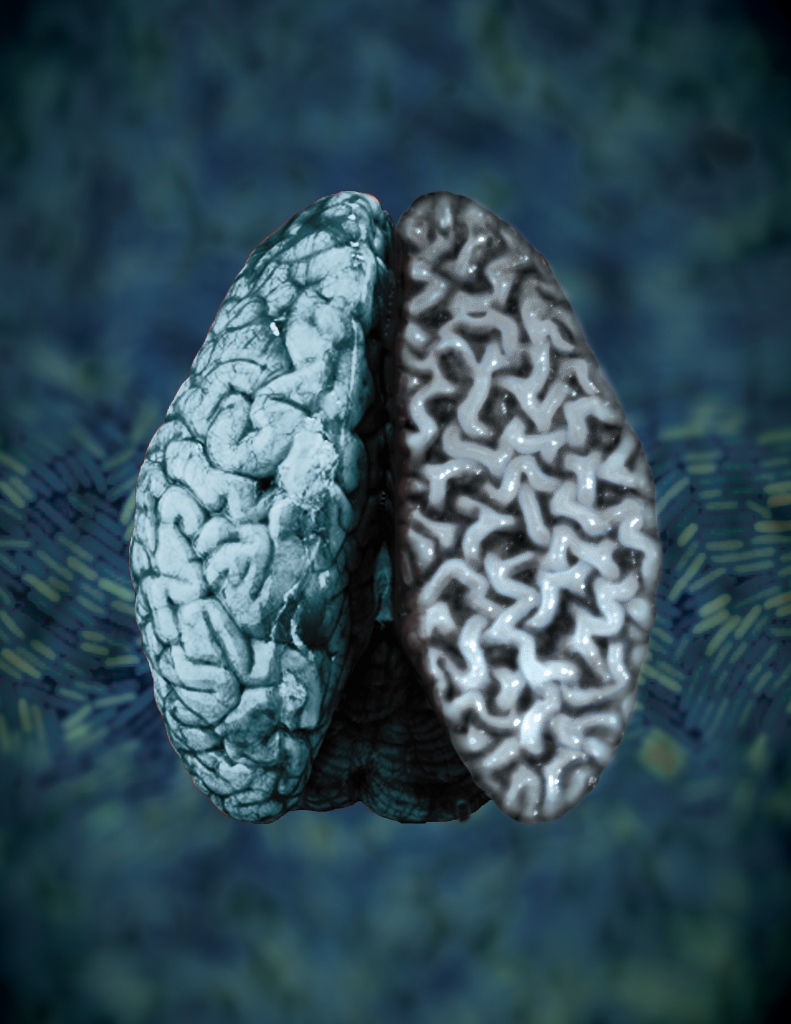Bacteria within a biofilm (in background and close up in right hemisphere inset) have similar electrical signaling mechanisms as neurons in the human brain. Credit: Suel lab
Biologists at UC San Diego have discovered that bacteria—often viewed as lowly, solitary creatures—are actually quite sophisticated in their social interactions and communicate with one another through similar electrical signaling mechanisms as neurons in the human brain.
In a study published in this week’s advance online publication ofNature, the scientists detail the manner by which bacteria living in communities communicate with one another electrically through proteins called “ion channels.”
“Our discovery not only changes the way we think about bacteria, but also how we think about our brain,” said Gürol Süel, an associate professor of molecular biology at UC San Diego who headed the research project. “All of our senses, behavior and intelligence emerge from electrical communications among neurons in the brain mediated by ion channels. Now we find that bacteria use similar ion channels to communicate and resolve metabolic stress. Our discovery suggests that neurological disorders that are triggered by metabolic stress may have ancient bacterial origins, and could thus provide a new perspective on how to treat such conditions.”
“Much of our understanding of electrical signaling in our brains is based on structural studies of bacterial ion channels” said Süel. But how bacteria use those ion channels remained a mystery until Süel and his colleagues embarked on an effort to examine long-range communication within biofilms—organized communities containing millions of densely packed bacterial cells. These communities of bacteria can form thin structures on surfaces—such as the tartar that develops on teeth—that are highly resistant to chemicals and antibiotics.
The scientists’ interest in studying long-range signals grew out of a previous study,published in July in Nature, which found that biofilms are able to resolve social conflicts within their community of bacterial cells just like human societies. When a biofilm composed of hundreds of thousands of Bacillus subtilis bacterial cells grows to a certain size, the researchers discovered, the protective outer edge of cells, with unrestricted access to nutrients, periodically stopped growing to allow nutrients—specifically glutamate, to flow to the sheltered center of the biofilm.
In this way, the protected bacteria in the colony center were kept alive and could survive attacks by chemicals and antibiotics. Realizing that oscillations in biofilm growth required long-range coordination between bacteria at the periphery and interior of the biofilm, together with the fact that bacteria were competing for glutamate, an electrically charged molecule, prompted the researchers to speculate that the metabolic coordination among distant cells within biofilms might involve a form of electrochemical communication.
The scientists noted that glutamate is also known to drive about half of all human brain activity. So they designed an experiment to test their hypothesis. The object was to carefully measure changes in bacterial cell membrane potential during metabolic oscillations.
The researchers observed oscillations in membrane potential that matched the oscillations in biofilm growth and found that ion channels were responsible for these changes in membrane potential. Further experiments revealed that oscillations conducted long-range electrical signals within the biofilms through spatially propagating waves of potassium, a charged ion.
As these waves of charged ions propagate through the biofilm, they coordinated the metabolic activity of bacteria in the inner and outer regions of the biofilm. When the ion channel that allows potassium to flow in and out of cells was deleted from the bacteria, the biofilm was no longer able to conduct these electrical signals.
“Just like the neurons in our brain, we found that bacteria use ion channels to communicate with each other through electrical signals,” said Süel. “In this way, the community of bacteria within biofilms appears to function much like a ‘microbial brain’.”
Süel added that the specific mechanism by which the bacteria communicate with one another is surprisingly similar to a process in the human brain known as “cortical spreading depression,” which is thought to be involved in migraines and seizures.
“What’s interesting is that both migraines and the electrical signaling in bacteria we discovered are triggered by metabolic stress,” he said. “This suggests that many drugs originally developed for epilepsy and migraines may also be effective in attacking bacterial biofilms, which have become a growing health problem around the world because of their resistance to antibiotics.”
Besides Süel, other researchers involved in the study were Arthur Prindle, Jintao Liu and San Ly of UC San Diego, Munehiro Asally of the University of Warwick in the United Kingdom and Jordi Garcia-Ojalvo of the University of Pompeu Fabra in Barcelona, Spain. The study was funded by grants from the NIH’s National Institute of General Medical Sciences (R01 GM088428, P50 GM085764), San Diego Center for Systems Biology and the National Science Foundation (MCB-1450867).
